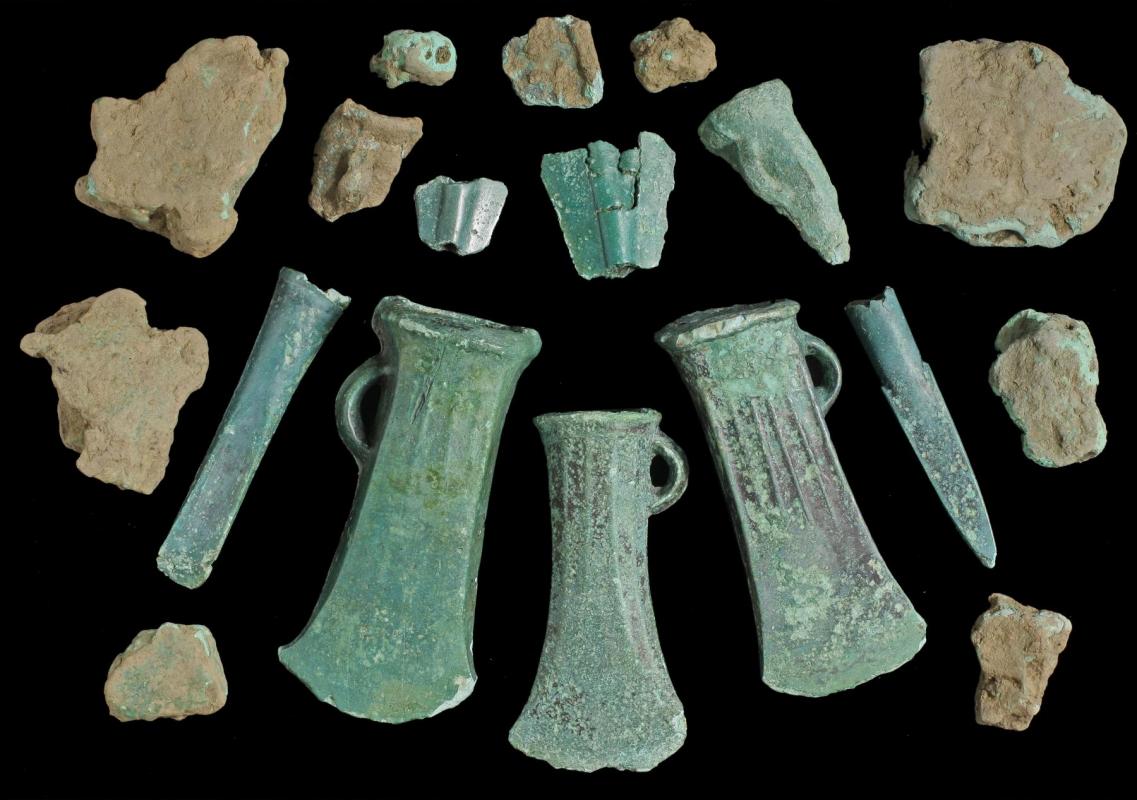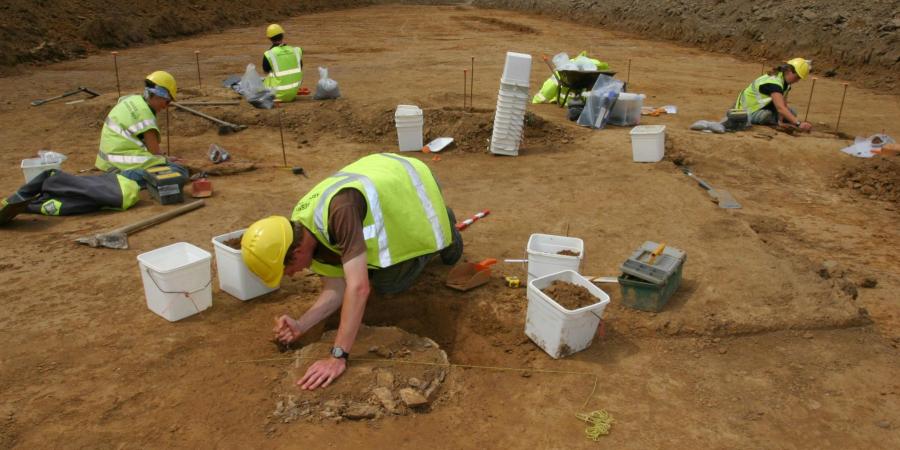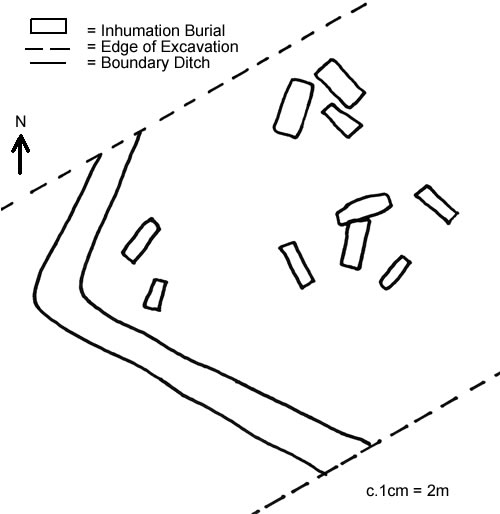In 2005 Southern Water Services commissioned Wessex Archaeology to carry out the excavation of archaeological remains along the route of two new pipelines.
The excavations described here were undertaken in advance of the Margate and Broadstairs Urban Wastewater Treatment Scheme (UWTS). The pipeline extends from Margate in the north to the Weatherlees Hill Wastewater Treatment Works in the south, and to the Broadstairs Headworks in the south east. The two branches of the pipeline extend over a distance of 13km, making this the longest excavation in Thanet.
More than 650 finds and sites were recorded, most between Manston airfield and Weatherlees Wastewater Treatment Works. There were 13 areas with significant archaeology, five of which are briefly summarised here.

To find out more about these site purchase the book here.
Star Lane
A small Palaeolithic handaxe was discovered at Star Lane, but surprisingly little material from this period has been found in Thanet.
A decorated pottery vessel, buried upright in a circular pit was probably part of a Middle-Late Bronze Age funeral rite, although no bones were found. The charcoal from the pit was analysed, and the hawthorn, apple and pear represented are strongly suggestive of the wood from a funeral pyre. Similar finds have been uncovered in other locations; they may be cenotaphs - memorials where the body was not available for cremation.
Medieval features were found in most of the areas along the pipeline, the majority drainage ditchs and field boundaries. A particularly interesting discovery at Star Lane was the remains of what may have been a medieval bakery. It was close to the edge of the enclosure, and measured about 3.5m x 3m. Within the shallow, rectangular pit which formed the perimeter of the building were a large and a small oven. The larger oven was a circular clay structure, and would probably have had a domed roof. It was built upon a layer of flint cobbles and shells. The smaller oven lay less than 0.5m from the large one and was of simpler construction. Grains of barley, with a few of rye and wheat were found in the bakery. Since cereal would have been ground into flour before arriving at the bakery, these grains are a bit of a mystery. They may have been thrown into the oven to test the temperature or else used to prevent loaves from sticking while they were cooking.
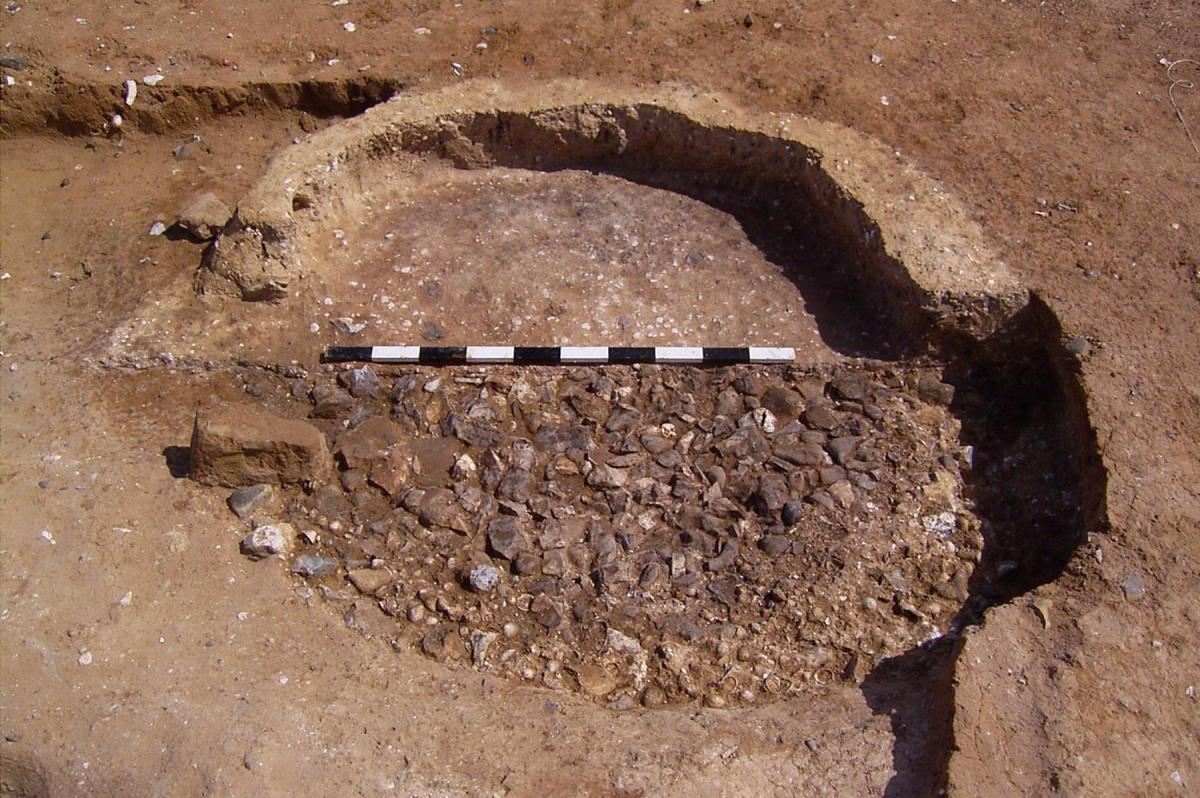
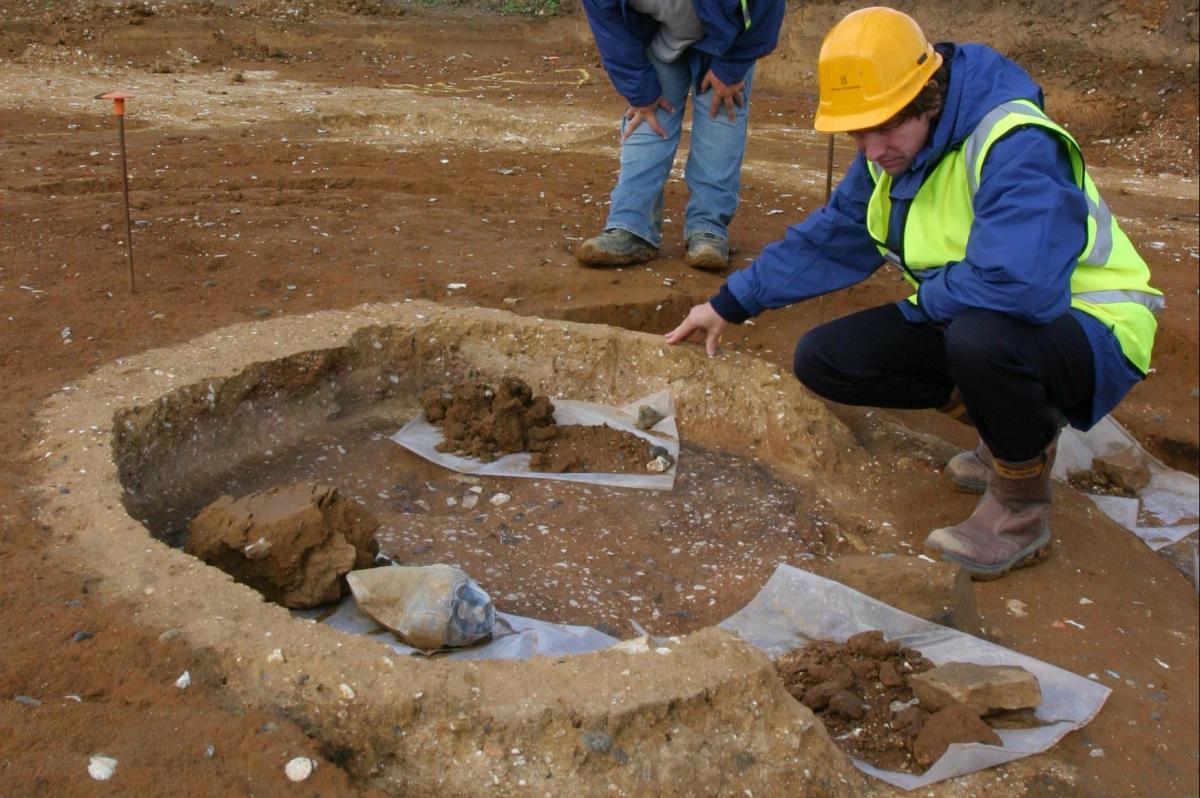
Coldswood Road
At Coldswood Road a large number of ditches dating to the late Iron Age - early Roman-British and medieval periods were found, giving us a picture of small enclosed fields with a hollow-way. Next to the hollow-way was a cemetery with the remains of seven early Romano-British, unurned cremation burials. There were metal casket fittings in four of the graves and all had been buried with pottery vessels. The pots were used to date the burials to the period of Claudius and Nero - making the casket burials some of the earliest found in Britain.
The cremation burials were not inside pots, as is common during this period. They were probably just put into small containers of wood, textile or leather and placed in small pits. The photo (right) shows one of these pits with a pile of cremated bone (upper right) beside three pots placed as grave goods. These do not contain any cremated bone. Click the image to see a more detailed plan of this cremation.
A rare, good example of a fine quality, complete circular grindstone was found in one of the medieval enclosures at Coldswood Road. It probably came from the Lower Greensand of Kent (Folkestone - Maidstone) where various outcrops are known. Such stones were used to sharpen knives and swords. A grindstone suggests there was a smithy in the area, but no iron slag was found to support this.
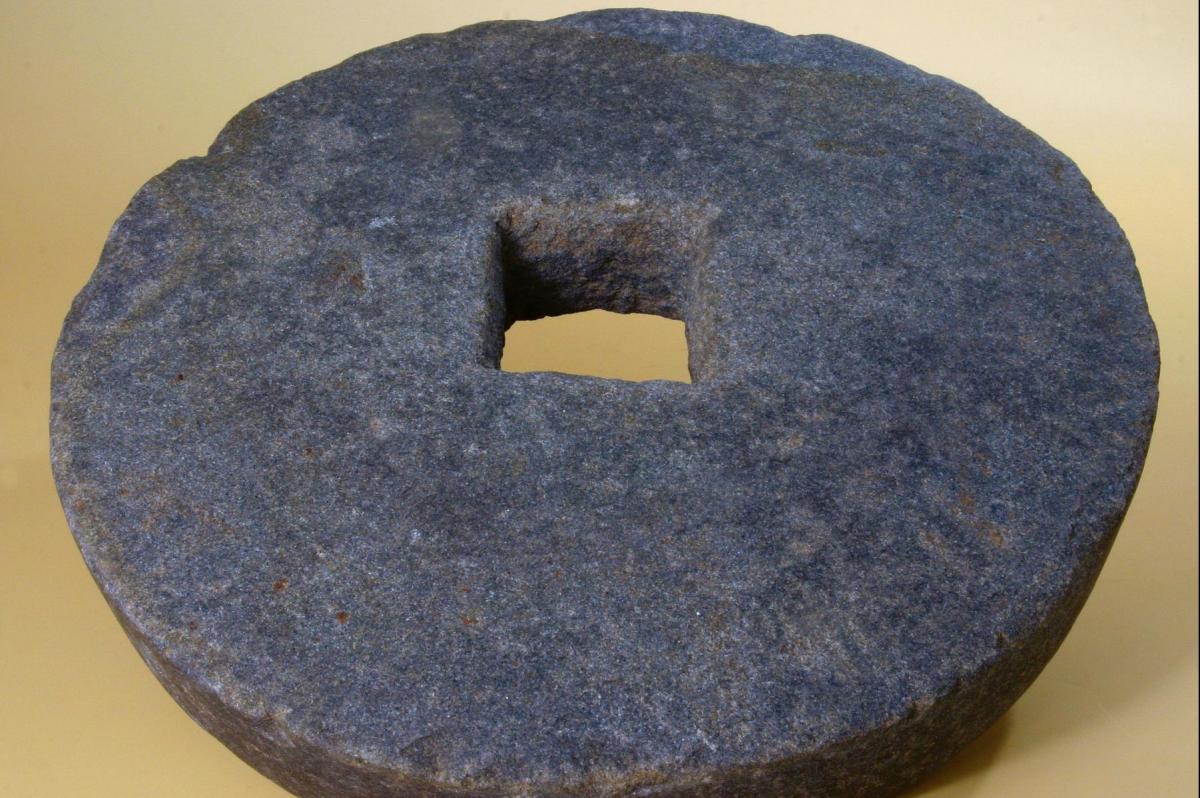
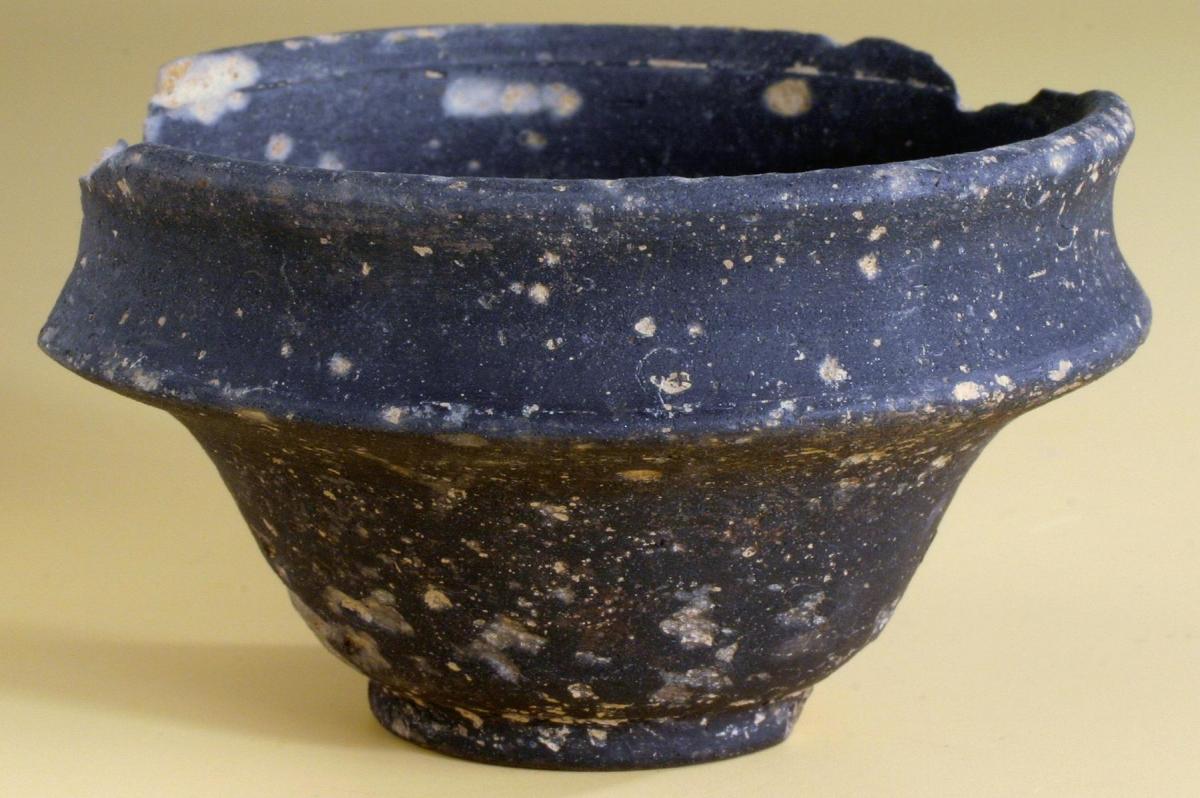
Specialist Reports
These specialist reports are for the Weatherlees-Margate-Broadstairs archaeological excavations along the route of a wastewater pipeline. They accompany the Wessex Archaeology publication Report 24 “Kentish Sites and Sites of Kent: a miscellany of four archaeological excavations”.
The links will take you to view the reports from within your web browser, using the Scribd document service. PDF versions of the reports are also available to download from our server at the bottom of this page.
- Kentish Sites and Sites of Kent Specialist Report 1: Site Concordance
- Kentish Sites and Sites of Kent Specialist Report 2: Later Prehistoric and Romano-British Pottery Report
- Kentish Sites and Sites of Kent Specialist Report 3: Human Bone Report
- Kentish Sites and Sites of Kent Specialist Report 4: Margate Animal Bone Report
- Kentish Sites and Sites of Kent Specialist Report 5: Charred Plant Remains
Downloads
1 - Site Concordance 2 - Later Prehistoric and RB pottery 3 - Human bone 4 - Animal bone 5 - Charred plant remainsCottingdon Road
Neolithic sites are scarce on Thanet, but a small number were found along the route of the pipeline, including a possible mortuary structure at Broadley Road and four small pits at Cottingdon Road. The round pits contained Mortlake-style pottery, flint tools and waste, charcoal and burnt flint, charred hazelnut shells and a hammerstone. The artefacts had been deliberatley chosen and placed in the pits.
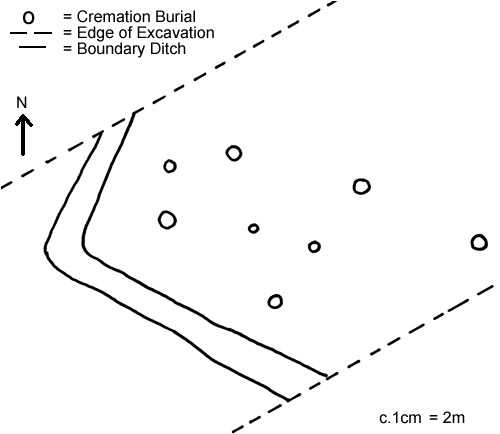
Plan of cremation cemetery
A small Romano-British cemetery (AD43-410) was excavated. In it were both creamation graves and inhumations (burials of unburnt bone).
The Cremation graves
Seven of the cremation deposits were placed in urns, of which five were amphorae. These are vessels that were used to transport wine, olive oil or fish sauce from the Mediterranean.
Grave goods had been placed within the amphorae.
Plan of inhumation cemetery
The excavation process
Stage 1
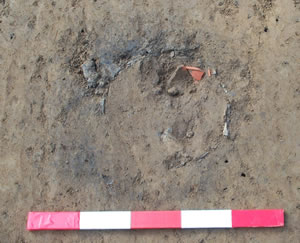
Firstly the archaeologists use their skill and experience to spot a potential cremation burial in the ground. They then survey its location and take a pre-excavation photograph (left).
Stage 2
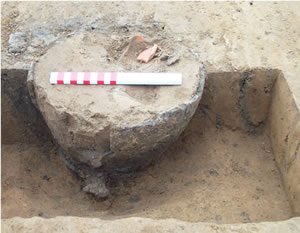
The second stage is to excavate the soil from around the outside of the urn. If there appears to cremated bone or pyre debris around the urn this is done in quadrants. The soil is then bagged and taken away to be processed. Once the soil has been removed the urn is wrapped in bandages to stabilise the pottery and allow it to be lifted from the ground with the contents of the urn still in place.
Stage 3
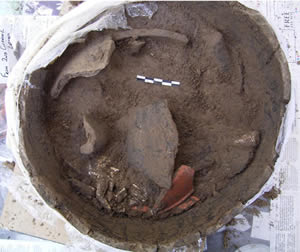
The soil within the urn is carefully excavated. Where possible the cremated bone is removed by an osteoarchaeologist who can identify some of the bone as it is removed. If this is not feasible, the urn is emptied in consistent 2cm spits. Recording in this manner enables the position of any gaps or grave/pyre goods within the vessel to be noted. The osteoarchaeologist can then work out the order in which the bones were deposited and the number of individuals. They also look for other remains such as animal bones within the urn.
Stage 4
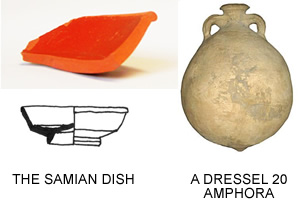
Any objects found within the urn are then examined by a team of specialists. In this instance the pottery was identified as Romano-British. Inside the urn were two vessels, one a storage jar and the other a samian dish. The urn/amphora was also identified as being of a typology known as Dressel 20, the most commonly found type of amphora in Roman Britain.
The Inhumation graves
A minimum of 13 individuals were identified. They had been buried in graves that were aligned roughly north-south, mainly following the enclosure boundaries. The human bone was generally poorly preserved within the soil, although the deeper the grave the better it was preserved. A number of grave goods were found, including a jug and a bronze buckle.
The small multi-rite cemetery reflects the national trend, which by the middle part of the 2nd century saw a change from cremation to burial.
Only a few Anglo-Saxon features were recorded along the route of the pipeline. One of them was a sunken-features building at Cottingdon Road. The 7th century Grubenhaus lay to the west of the cemetery. It was of a size and form that is typical of these buildings in England, Scandinavia and northern Germany. Pottery and charcoal analysis suggest that this was a domestic building.
Cottington Hill
An intricate network of drainage ditches and areas of compacted chalk suggest this was once an area of boggy or marshy ground. Perhaps because of this, there is little other evidence of human activity within the area.
The only archaeological finds of note were two inhumation burials, one of a man and one of an infant. These are of interest as they had not been placed in a cemetery although they lay close together. The burials can be dated from grave goods such as complete pottery vessels from the Romano-British period (AD43-410).
At the end of a boundary ditch was another burial, this time of Saxon date. The head was to the west and the feet hard up against the end of the ditch, and it seems likely that the grave was cut into the ditch and immediately backfilled so it would not be seen. The occupant of the grave was a man under the age of 50, who had probably suffered with poor dental health and seems to have had an infestation of headlice.
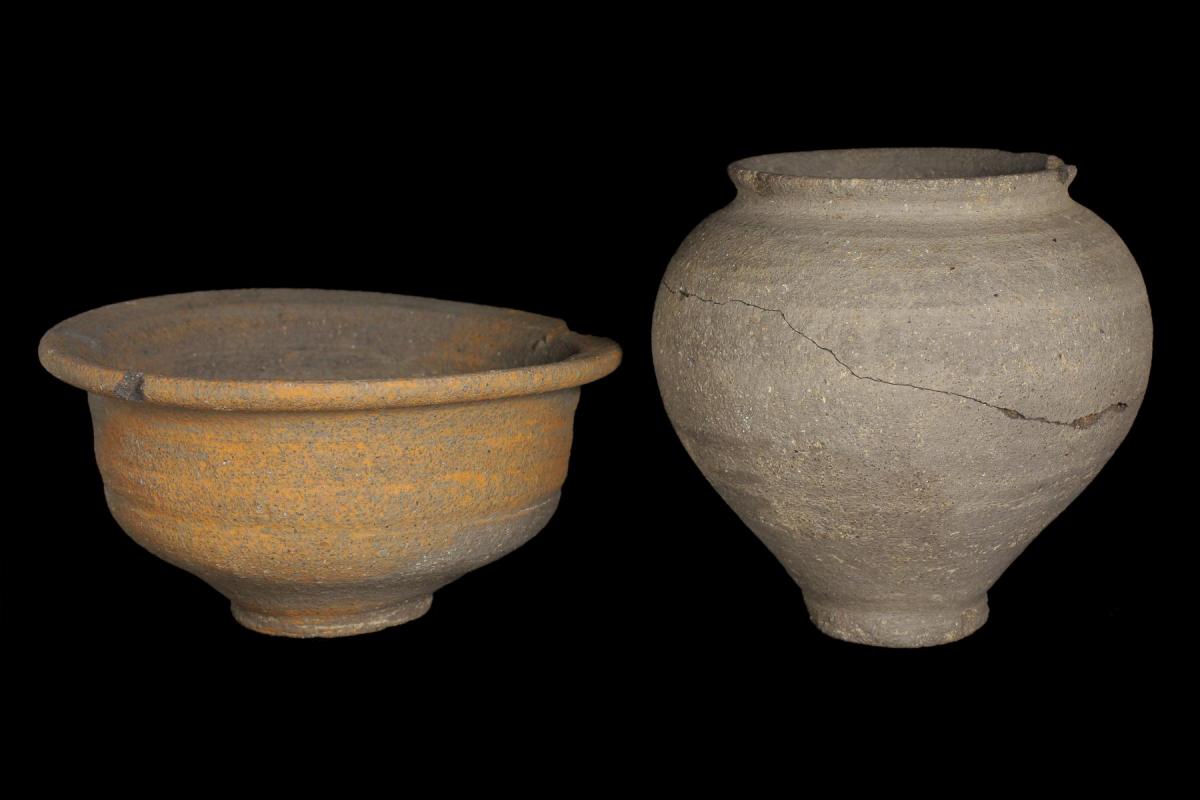
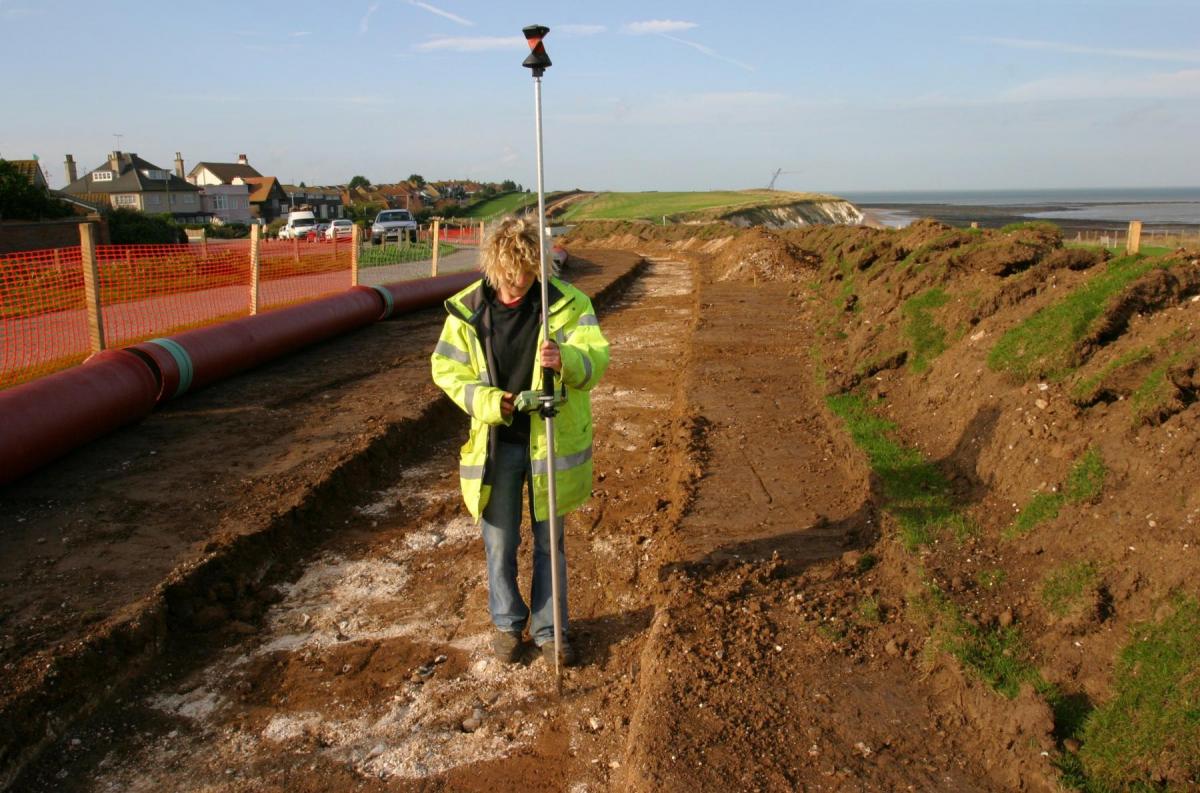
Weatherlees Waste Water Treatment Works
A number of features were recorded in this area including pits, postholes, two inhumation burials, midden deposits (rubbish pits) and ditches. The ditches dated to the prehistoric (4000 BC-AD 43), the Romano-British (AD 43-410) and medieval ( 1066-1499) periods respectively. The pits and postholes too ranged in date from the prehistoric to the medieval period. The midden deposits were both Bronze Age in date. One of the Romano-British pits contained the complete skeleton of a dog. The two graves were cut into the top of a Romano-British ditch.
There were no grave goods to help date them, but they are probably from the Romano-British period. They appear to have been deliberately placed here, but why remains uncertain.
Previous archaeological evaluations by Wessex Archaeology in 2004 revealed a most spectacular find in this area; two Late Bronze Age (1100 - 700 BC) hoards of metal work. The main objects from the first hoard were 3 bronze socketed axes. The second hoard was larger than the first and contained 3 complete and 2 incomplete bronze socketed axes, a bronze chisel, a bronze gouge, 2 fragments of socketed spearheads and 9 ingots or bars of bronze. Both hoards were dated more precisely to the 8th century BC. A number of hoards have been found on Thanet, but the Ebbsfleet area stands out with five hoards found to date, emphasising the importance of the Ebsfleet peninsula. The number of ingots is evidence of an efficient industry that was producing weapons and tools, as well as recycling scrap metal.
